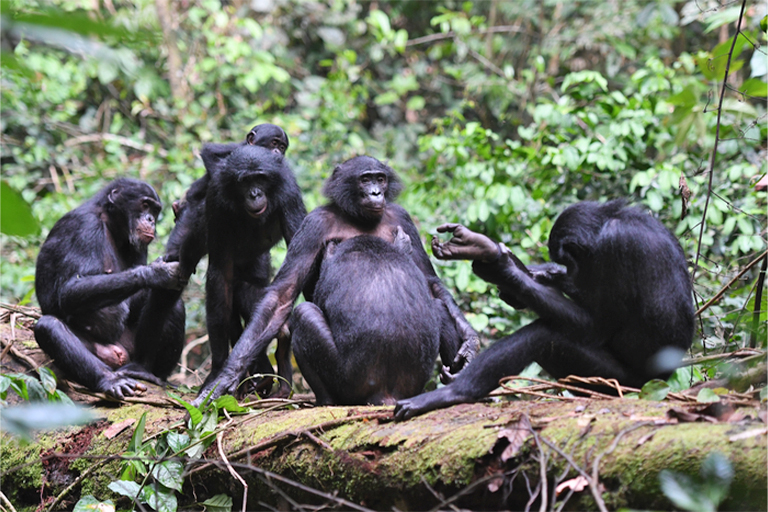- Bonobos are well known for their peaceable relations within family groups, but there’s less scientific consensus about how much tolerance they extend to individuals outside of their core groups.
- A recent study set out to examine this question by observing members of habituated bonobo communities in the Democratic Republic of Congo, and comparing their behavior to observations of chimpanzee groups in Uganda’s Kibale National Park.
- The researchers found that, compared to chimpanzees, bonobos maintain strong and distinct core groups, but also exhibit frequent and peaceable between-group interactions.
- The findings give conservationists a better understanding of bonobo social behavior, which in turn can inform conservation actions.
Bonobos, sometimes referred to as the “hippies” of the ape kingdom, have long been known for their relatively peaceful relations within core family groups. But there’s been less consensus about how amicably bonobos (Pan paniscus) interact with individuals outside of their family structure.
A recent study set out to measure how much tolerance bonobos extend to individuals perceived as members of an outside group — a behavior that has been routinely challenged due to a lack of data on the species’ group dynamics.
Researchers followed habituated bonobo groups in the Democratic Republic of Congo’s Kokolopori Bonobo Reserve and compared their behavior to chimpanzee groups in Uganda’s Kibale National Park.
According to their research, published in the Proceedings of the National Academy of Sciences, bonobos form distinct and stable core groups, but also exhibit flexible associations and frequent tolerant and cooperative between-group interactions.

Frequent and peaceable interactions
Liran Samuni, lead author of the study, told Mongabay in an email that while bonobos do appear to be tolerant of unfamiliar individuals, research is limited as to whether bonobos perceive these unknown individuals as belonging to a socially distinct “out-group” or simply as part of a large, looser group of bonobos.
“This is the main question we wanted to tackle — do bonobos form groups that are socially distinct from one another? Or is what we see in bonobos simply tolerance between ‘neighborhoods’ of the same large group with no in-group or out-group distinction?” said Samuni, a primatologist at Harvard University.
Between January 2017 and December 2019, observers followed bonobo groups daily from dawn to dusk, recording their behavior with the aim of characterizing their social structure.
They collected data on all adults and adolescents older than 10 years during 1,000 days of observation of the Ekalakala group, 1,075 observation days of the Kokoalongo group, and 257 observation days with the Fekako group. The observers focused primarily on how much time individual bonobos spent together, who they spent time with, and what they did.
These observations were then contrasted with data collected in Kibale, where the Ngogo chimpanzee community has been under continuous observation since 1995.

The researchers found that bonobos consistently returned to the same, defined core group, while also frequently interacting with members of other groups.
Just like other bonobo populations, young females in Kokolopori regularly moved between different groups. In addition, male bonobos were observed to move between groups more flexibly than male chimpanzees. They further found that despite these frequent outside interactions, group membership was stronger in bonobos than in chimpanzees,
“The bonobo group membership was consistent and stable over time despite frequent and prolonged associations between different groups that lasted from a few hours to two weeks,” says the study.
According to the study, these findings suggest the presence of a bonobo social organization that features clear in-group and out-group differences while also demonstrating out-group tolerance. In other words, the researchers concluded bonobos do form distinct communities, while still frequently and peaceably interacting with individuals from other groups.

A species facing many challenges
The research encountered a number of challenges. Few bonobos are left in the wild, while political instability in the DRC and habitat loss add to the list of challenges.
“Further, that we are only able to study a handful of bonobo populations limits our ability to understand the diversity and variation of bonobo behavior across populations,” Samuni said.
Nevertheless, the study is vital as it could support efforts for the conservation of bonobos, says Philip Muruthi, vice president of the African Wildlife Foundation (AWF).
Muruthi, a specialist in species and conservation, says understanding the social behaviour of the bonobos and other wildlife is the first step to understanding how to manage their habitat to conserve the species. Knowledge of their social behavior gives an idea as to activities that can disrupt their society and their ecosystem, and affect their survival or sustainability.
“Studies like the one in question help us understand how they socialize, how they forage, where they prefer to sleep and how much space they need. Understanding these is key to management of their habitat and, ultimately, their conservation,” Muruthi said.
Such knowledge, he added, is also critical generally in preventing human-animal conflict and in reintroduction of species when necessary.
Related reading:
Unrelated adoptions by bonobos may point to altruistic traits, study says
Banner image: Bonobos, sometimes referred to as the “hippies” of the ape kingdom, are known for their relatively peaceful relations within core family groups. Image by Zweer de Bruin via Flickr (CC BY-NC-ND 2.0).
Citation:
Samuni, L., Langergraber, K. E., & Surbeck, M. H. (2022, June 21). Characterization of Pan social systems reveals in-group/out-group distinction and out-group tolerance in bonobos. Proceedings of the National Academy of Sciences, 119(26). doi:10.1073/pnas.2201122119
FEEDBACK: Use this form to send a message to the author of this post. If you want to post a public comment, you can do that at the bottom of the page.
